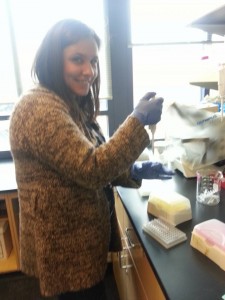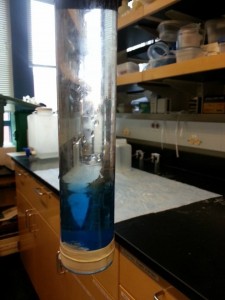 Michelle and I have spent most of April and June in the Becker lab preparing polymerase chain reactions for each of the three species we are sampling this summer (Pacific geoduck clam, Pacific oyster, Manila clam). This is an extensive, but necessary process that needs to be done as a foundation for the more complex real-time quantitative PCR, or qPCR for short.
Michelle and I have spent most of April and June in the Becker lab preparing polymerase chain reactions for each of the three species we are sampling this summer (Pacific geoduck clam, Pacific oyster, Manila clam). This is an extensive, but necessary process that needs to be done as a foundation for the more complex real-time quantitative PCR, or qPCR for short.
Any polymerase chain reaction is a sensitive and time-consuming process. Michelle and I ran into many issues with developing our PCR. One of the most complicated tasks to overcome, as many lab scientists would agree, is to prevent contamination. There are many materials and ingredients for PCR that are required in such small amounts (as small as 0.5 µl) that there are great opportunities for error. Also, the infamous and ornery complication with PCR is known as “primer dimer”. This is when a control, such as water, shows up after PCR to contain DNA. Hoping that our pure water wasn’t contaminated with DNA, we resorted to re-ordering the primers and have finally achieved success!
Now that PCR set-ups have been made for each species and our controls are all clear, we are anxious to get out into the water to gather our larval samples. By setting tube traps at each of four sites for 2-week intervals and also pumping seawater through sieves, hopefully we will return to the Becker Lab with more larvae than we can count! This is where qPCR will come in very handy.
 qPCR is a convenient tool in the way that it knocks out two steps in one method. qPCR identifies and quantifies a DNA sample as long as there are corresponding primers and probes in the mix. The species will be determined simply by using species-specific primers. For example, if we are using Manila clam primers and there is geoduck DNA in our sample, the only DNA that will be copied is the Manila clam. By using a fluorescent dye probe that glows on the amplified or copied DNA, the numbers of original DNA can be calculated by measuring the amount or intensity of fluorescent product formed. In other words, the more DNA of a certain species we began with in our sample, the brighter the glow will be after that DNA is copied. We will use this information to analyze population abundance by identifying the species in our water samples as well as the number of larvae present determined from the intensity of the fluorescence.
qPCR is a convenient tool in the way that it knocks out two steps in one method. qPCR identifies and quantifies a DNA sample as long as there are corresponding primers and probes in the mix. The species will be determined simply by using species-specific primers. For example, if we are using Manila clam primers and there is geoduck DNA in our sample, the only DNA that will be copied is the Manila clam. By using a fluorescent dye probe that glows on the amplified or copied DNA, the numbers of original DNA can be calculated by measuring the amount or intensity of fluorescent product formed. In other words, the more DNA of a certain species we began with in our sample, the brighter the glow will be after that DNA is copied. We will use this information to analyze population abundance by identifying the species in our water samples as well as the number of larvae present determined from the intensity of the fluorescence.
By pumping samples at different levels in the water column, during the day and at night, and above seagrass beds and bare seafloor, we can hopefully use the qPCR data from each of these variables to determine where the larvae like to live. We are especially interested in seeing if there is any correlation to larvae living among seagrass beds during periods of environmental stressors, such as pH and salinity fluctuations. Seagrass beds have been shown to have higher pH than surrounding water during the day. If we find that the larvae tend to concentrate over seagrass when the surrounding water is experiencing lower pH, this information could be used to save the shellfish from the negative effects of ocean acidification!
